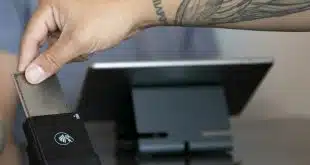The alphabet of money used to be the various coins that were put together to make a financial statement. Or similarly, the various denominations of bank notes that were bound to express a given sum. And then we invented computers, and a new language for money came forth. Money was written as a number representing value, associated with meta-data embodying a pointer to its owner and expressing various attributes, such as US$, €, or Yuan, debit, credit. That is how money is written today. Which is about to change.
The problem with today’s language is that money has no identity, only a value. By contrast, every banknote carries a unique serial number distinguishing it from other banknotes of the same value but of different identity. Identity is critical for something called tethering (see my book, Tethered Money). This is a process of tying a sum of money to terms of use. Identity-less money cannot be tethered. A written number, say, $10, has no identity. As money migrated to cyberspace, it lost its identity. And we had better restore it, using a new language.
A lump of matter (coin or banknote) carries an identity through an intrinsic multitude of properties, like weight, size, shape, color, fabric, and so on. Now, suppose we take a value, say $10, and express it as a string of 1,000 bits, where the identities of these bits are determined by a source of randomness. We call this action “minting.” We thereby bit-mint a $10 coin. To mint another $10 coin, we repeat the process, using again a source of randomness to specify the identities of 1,000 bits.
The nature of randomness is such that the second $10 coin will be different from the first. And even if we mint a gazillion $10 coins, there is no feasible chance for the identities of the respective bits to be the same. For perspective: The number of sand grains in all the beaches on earth is a tiny fraction of the number of different strings of 1,000 bits.
Bitminting is a process in which money is written such that it expresses value, $10 in our case. This money also has an identity, expressed in the particular string of 1,000 bits in which the $10 is written. Bitminted coins can also be tethered. And, of course, they can be identified.
Randomness, then, restores money to its pre-cyber era expression, with identity and value fused and inseparable. This act—upgrading money from a number (value) to a value plus identity—is the fundamental change cyber money brings. Before this new, bit-minted money language, the only way to authenticate a cyber-payment was to identify both the payor and the payee, so payment privacy vanished. Our payment history tells the government more than we wish to expose.
Because this new money will have an identity, we can check if it is tethered to an owner, or to terms. Because money will have an identity, we can suspend its status when it’s involved in criminal activity. Because money will have an identity, we can deposit it in an Internet-of-Things device and let our car pay parking fees. Because money will have an identity, we can split it into small measures and fire those bits as fast as electrons flow, thereby purchasing split-second services. Because money will have an identity, we can make cyber payments offline, when the Internet is down.
We have only begun to imagine what this new language of money will lead us to. Payments is the lifeblood of society. We’re just acquiring healthier arteries.
—Gideon Samid gideon@bitmint.com




